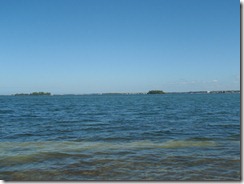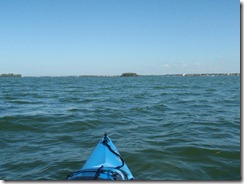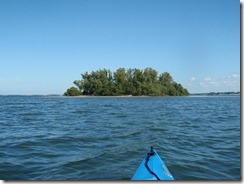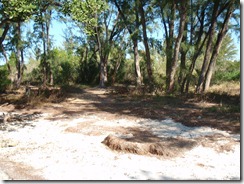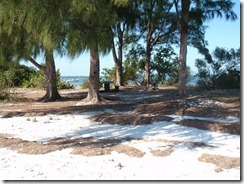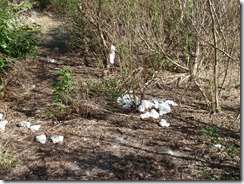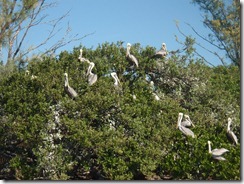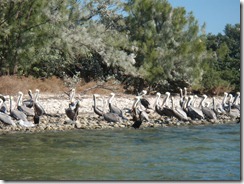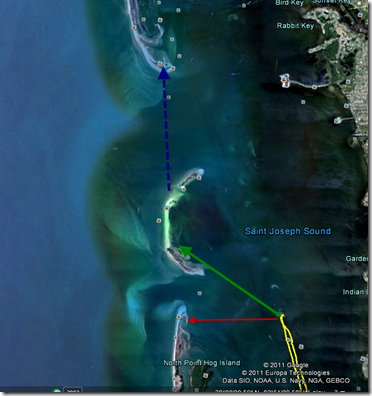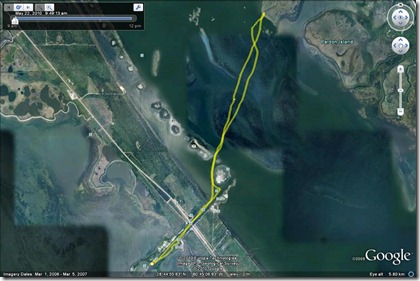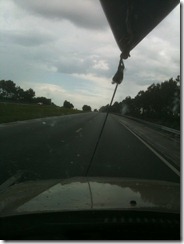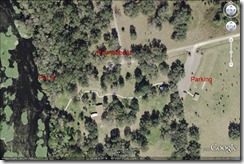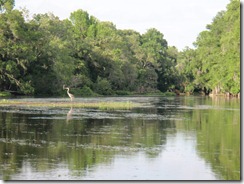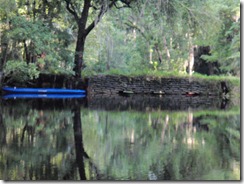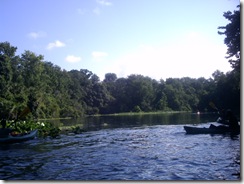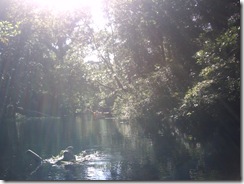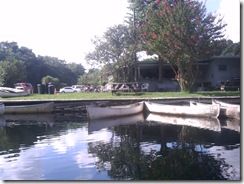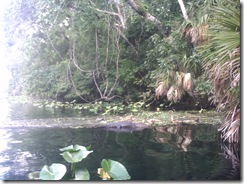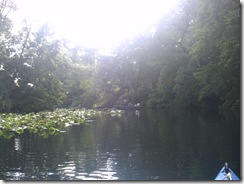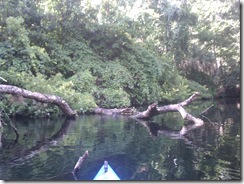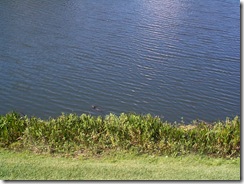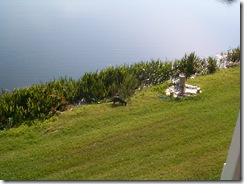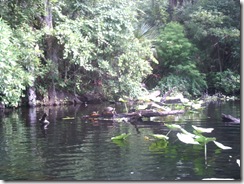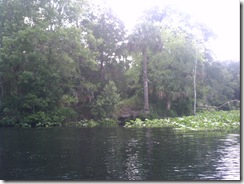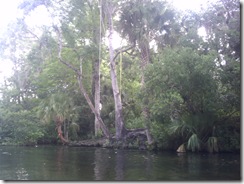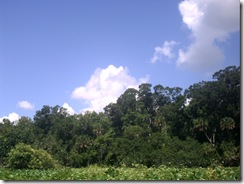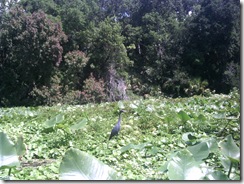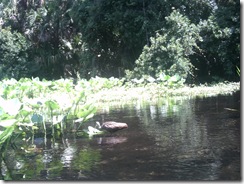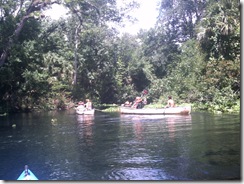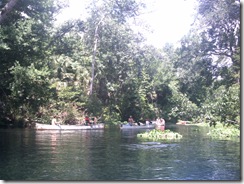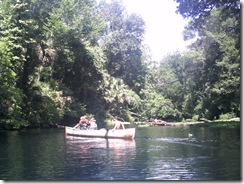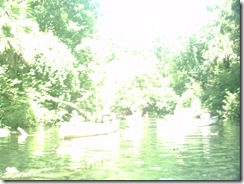Your cart is currently empty!
Category: kayaking
-
Afternoon on the Wekiva
An afternoon paddle on the Wekiva today, but no pictures or GPS due to battery issues. Those should be resolved before my next paddle, though.
I started at Wekiva Springs State Park and turned onto Rock Springs Run to paddle upstream until the water became to shallow to continue. Then I returned to the Wekiva and paddled downstream past the marina for an hour or two.
Two small gators, a number of birds, and a bevy of drunken paddlers from the marina. The highlight of the trip was a hawk carrying a squirrel (or some other small, furry dinner) that back-winged mid-river to reach a tree on the bank.
Part of this trip was to try out a couple pieces of new equipment.
First was a carry strap I got from topkayaker.net:
(stock photo – sadly neither the yak nor the brunette are mine)
I’ve used this the last couple trips, but those were short transfers. It worked well for those, but the 100-yard sand path from the parking lot to the launch at the Park would be a good test, with soft sand much of the way that tends to bog down some kayak cart wheels and a significant elevation change between the parking lot and the launch area.
So what I found was that the weight, even on one shoulder, wasn’t a problem. The 16’ length of the Tarpon is an issue, as it’s simply unwieldy to carry – controlling the ends, and such. The biggest issue for a long portage with this device is that the bottom of the boat presses against my leg just below the knee – so each step rubs that spot back and forth along the bottom edge of the boat.
On the trip down to the water the kayak had been on top of the car for a couple hours, so had plenty of time to heat up the plastic and it was uncomfortable. On the way back up again, the friction was noticeable – in fact, I believe there is a spot bare of hair on that leg now. Next time I’ll have to bring some pants to change into for the portage – that should alleviate the rubbing.
Next were these:
I’ve been looking at the Vibram Fivefingers brand for a while and my kayaking sandals are just about at the end of their useful life, so I decided to try a pair.
These are the KSO model, along with the Flow, designed for watersports.
So comparing them to the sandals I usually wear, I was favorably impressed. Yes, the having-stuff-between-your-toes thing takes a bit of getting used to, but aside from my left pinky-toe, all adjusted quickly and even that awkwardness went away once they got wet the first time.
I was in and out of the boat several times and when the water got very skinny on Rock Springs Run I got out and walked for a couple hundred yards pulling the boat.
The “feel” of these is very much like being barefoot, but still protected from rocks and logs. I didn’t have a need to perch on a log while pulling the boat over, but I do think these would provide better grip and balance than sandals.
The bottom of Rock Springs Run is more sand than mud, but there are spots where the sand isn’t hard-packed and your feet sink. These were easier to deal with in the KSOs than in sandals. With sandals, once you’re foot sinks, pulling it out often creates a void between the sole of your foot and the sandal – that creates some suction and makes it more difficult to get out. These both stay on and avoid that problem.
The fit around the ankle is tight enough that very little sand or dirt is able to get into the shoe.
Overall quite comfortable and effective.
-
Florida Keys
With a new car that gets much better mileage than my V8 Mountainer (even if a 16’ boat on 14’ Prius does look a bit silly), I can now worry more about where I want to paddle than how much it will cost me to get there and back.
Since Orlando to Key Largo costs about $25 with this new rig, I decided that’s where I wanted to go this weekend. Unfortunately, the weather didn’t cooperate, with 15+MPH winds Saturday and Sunday, I was only able to paddle on Friday and Monday.
After driving down and checking in at my hotel in the morning, I stopped at Florida Bay Outfitters for a new hat and rash-guard shirt. Since I was there and they’d started selling their rental fleet for the off-season, I also bought a boat … which will bring to five the count of boats in my garage when I pick it up in July.
Now, five boats may seem excessive to some people, but each has its own specific purpose and use. So to
justify myselfexplain each boat’s purpose:- My primary boat is the 16’ Tarpon pictured above. It’s stable, tracks well, and it’s generally comfortable, except for the still-missing
ass-padseat cushion that I still haven’t replaced. - Then I have a Pamlico tandem, which I’ll likely be selling soon, as I have a new rule of never going with someone who won’t paddle their own damn boat.
- Next is a 9.5’ Swifty that’s mostly used by my daughter, but it’s a light, handy, cockpit boat that’s nice to throw on top of the car for a quick paddle in the morning or afternoon.
- Lastly is an Ocean Kayak surf boat which I got
to have a surf boatfor the boy-child to use.
The new boat will be a 14’ Tarpon 140:
This will give me a boat similar to my primary, but a bit shorter (easier to control) for when I want to take someone who doesn’t have their own boat. In addition, it has a rear well instead of a hatch, so it’ll comfortably hold dive gear.
See? I absolutely need five boats …
Friday Afternoon – Lignumvitae Key
2.5 hours – 5.5 miles
My plan for the weekend was to paddle the three Keys accessible from the causeway between Upper and Lower Matecumbe Keys, Lignumvitae, Shell, and Indian Keys, with a possible diversion to snorkel at the wreck of the San Pedro (about a mile south of Indian Key):
I took a quick paddle around Lignumvitae – it was a beautiful day, with little wind and crystal clear water. On the way back across the flats, I passed a 3’-4’ nurse shark cruising along the bottom.
Saturday & Sunday
The weather forecast for the weekend called for 15+mph winds. When I arrived at the put-in Saturday morning, it was clear that the wind would be an issue on either the Gulf or Bay sides, so I took the opportunity to spend the day in Key West.
That turned out to be a good decision, as the beach rental at Smather’s Beach in Key West claimed 20-30mph winds and Bahia Honda wasn’t even renting kayaks because of the wind.
More of the same on Sunday, so I drove to Everglades National Park and spent the day there.
Monday Morning – Blackwater Sound
3.75 hours – 10.3 miles
The forecast for Monday called for 10mph winds dropping to 5mph in the afternoon. I put-in at Florida Bay Outfitters and paddled across Blackwater Sound to Dunedin Creek, taking a bit of a detour into the mangrove creeks to explore.
Coming out of Dunedin, I made for the western edge of Little Buttonwood Sound, which put the paddle at five miles. My plans were to head west from there toward Porjoe Key and then on to North and South Nest Keys.
At this point, though, the winds did not seem to have died down and were out of the East and Southeast, so continuing the trip another five miles to Nest Keys would mean a ten mile return mostly into the wind – with the first half of it giving the wind a five mile fetch across open water.
If I’d had camping gear with me, I’d have taken the chance, knowing I could just stay overnight and paddle back the next day. In fact, I think I’ll do that next time.
- My primary boat is the 16’ Tarpon pictured above. It’s stable, tracks well, and it’s generally comfortable, except for the still-missing
-
Saint Joseph Sound Spoil Islands
December in Florida. On the water at 11:30, clear blue skies and 72-degrees.
This was a trip to visit the spoil islands in Saint Joseph Sound to pick one for camping in a few weeks. Spoil islands are the result of dredging channels – the material dredged from the bottom of the channel is loaded on a barge and the barge is periodically dumped to the side of the channel.
This results in evenly spaced islands (or bars if there wasn’t enough material) along the line of the channel. In this case there are six islands about a half mile apart running north of the Dunedin-Honeymoon Island causeway. The channel continues to the north, but the islands stop – the northern dump sites didn’t rise to the level of islands.
(open in Google Earth)
(7 miles – 3:30)There’s a lot of rock and oyster shell around the causeway and islands, much of it exposed at low tide, which is when I arrived to put in. The oyster shell will tear up a boat faster even than rock, so don’t drag your boat over it. Also watch your step, as it’ll slice your feet up just as easily.
I set course for the first island in the chain and started off. Getting there from where I put in on the causeway meant crossing the boat channel. I always laugh at kayakers who start talking about marine law and right-of-way regarding powered boats. In my book, right-of-way goes to who won’t wind up as flotsam and chum after the collision, so I always make sure the channels are clear for a long ways before trying to cross.
This is not clear enough:
The reason we wait until it’s completely clear, of course, is because no matter how well the day’s going, no matter how swift your stroke is … dead center of the channel will be the spot your cooler decides to slide off the back deck of the boat and become a sea anchor. Did this happen today? Of course it did. This is why I want a new boat.
On some of the islands, local conservation groups are busily at work replacing non-native vegetation. While I can agree with this in principal, I still think the Australian pines just look better than native growth.
The first and second islands north of the causeway have rock fire pits and cleared areas suitable for camping. The second is larger and someone has brought in a picnic table.
Both were nicely free of trash, with only a few cans or bottles around. Most of these had already been placed in the fire pits.
On the first island, though, there’s clearly a “bathroom” area that some people aren’t following “leave no trace” in.
If you can’t handle packing it out, then stay somewhere there’s a toilet.
The third island north of the causeway is an Audubon sanctuary, so landing is not permitted. The fourth was inaccessible during my trip due to the tide – exposed rock and oyster shell made landing a bad idea.
Island five had a little surprise in store for me. The low tide exposed a spit of sand and an odd looking rock that turned out to be this little guy:
Not every day that you see one of these on the beach.
The last island in the chain is small and rocky, with only a few scrub trees for cover.
Even so, if the weather forecast is good, it will probably be my choice for camping, because it’s isolated and well-positioned as a base. From here, it’s only two miles to either Honeymoon (red) or the bars north of Honeymoon (green), and from them it’s only another two miles to Anclote (blue).
-
Happy Birthday at Haulover
For my birthday morning, I took my daughter and a friend of hers to Haulover Canal.
View Haulover Canal in a larger mapAfter a long drive to pick up her Little Boy Friend*, we hit Subway for breakfast and to pick up lunch. At Subway, they gave me a Sharpie to put our initials on the lunch sandwiches, which, of course gave me the opportunity to write LBF on her friend’s – he seemed to have a sense of humor about it, she erupted in a chorus of “I can’t believe you did that!”
Kayaking and annoying the girl-child … life is good.
We were on the water by 10:00 and headed up the canal.
GPS tracking powered by InstaMapper.com
I put the kids in a tandem Pamlico while I paddled my Tarpon.
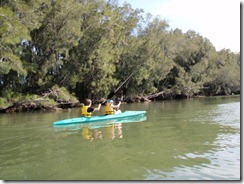 Shortly into the paddle, we spotted the first dolphin of the day.
Shortly into the paddle, we spotted the first dolphin of the day. And shortly after that, the manatees.
And shortly after that, the manatees.
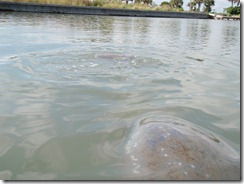
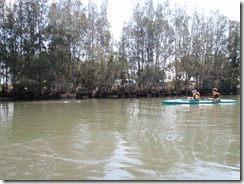 We left the manatees and the kids did a little exploring of Haulover’s unique shoreline.
We left the manatees and the kids did a little exploring of Haulover’s unique shoreline.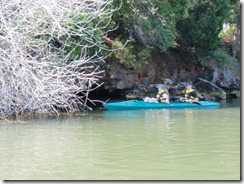 Shortly after this picture, they drifted closer to the branches and I heard the girl-child express her concern that a snake might drop on her. (You may express your ridicule in the blog comments and I’ll make sure she gets them.)
Shortly after this picture, they drifted closer to the branches and I heard the girl-child express her concern that a snake might drop on her. (You may express your ridicule in the blog comments and I’ll make sure she gets them.)Under the bridge and past the manatee observation deck, there was a pair … sporting.
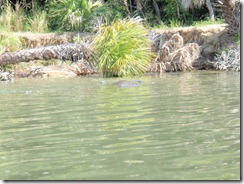 Some conversation in the other boat about what they were doing prompted the girl-child to ask me what I thought:
Some conversation in the other boat about what they were doing prompted the girl-child to ask me what I thought:“Well, sweetheart, when a mommy manatee and a daddy manatee love each other very much …”
“So you think they’re having sex too.”
A short way further along I spotted an alligator near the bank, but he sank out of sight before I could get a picture.
We exited the canal to the North – here are the mangroves where I stopped us to tell the kids the Mangrove Story.
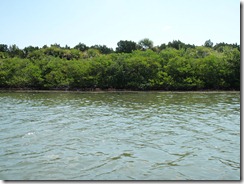 What’s the Mangrove Story? Well, I believe that we should take advantage of opportunities to educate children:
What’s the Mangrove Story? Well, I believe that we should take advantage of opportunities to educate children:“Mangroves are very important to the coastal eco-system, because their roots provide a protected environment that acts as a nursery for many different species of fish, crabs and shrimp.
“Interestingly, if you take a 10’x10’ piece of nylon netting and some lead weights and use them to submerge a body amongst the roots … in two weeks it’ll be nothing but bones from all those little baby fishes and crabs.
“You should remember that as you spend time hanging out with my little girl.”**
The kid seemed to be a good sport about this story, too, because, of course and on advice of counsel, the Mangrove Story is just friendly kidding.
Just before heading out into the lagoon, we came across a barnacle-covered piece of driftwood.

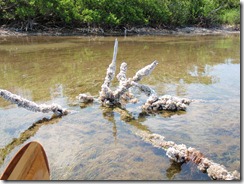 The wind was out of the NE today, so we headed in that direction, crossing the lagoon before stopping to drift back as we ate lunch.
The wind was out of the NE today, so we headed in that direction, crossing the lagoon before stopping to drift back as we ate lunch.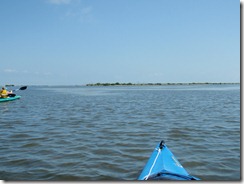 After lunch, on the way back, the girl-child will claim I fell in the water. I deny this charge. Here’s what happened:
After lunch, on the way back, the girl-child will claim I fell in the water. I deny this charge. Here’s what happened:Because I had forgotten to bring towels, I was unable to improvise a
ass-padseat cushion as I have recently. After the paddle across the lagoon, the lack was being felt, so I stood up to stretch my legs.The Tarpon is a very stable boat, so standing up is not foolish. I’ve stood in it to fish before with no problems on calm water, and it was quite calm today.
From my standing position I was enjoying the view of the clear, shallow water when I spotted what I thought was a small turtle. A second look showed that it was a large crab and since the water was so shallow and clear, I wanted to get a good picture of it, so I quickly sat down.
Standing in the Tarpon is perfectly okay … sitting quickly, not so much.
So, yes, part of me left the boat, but since it was only one leg and became wet only to the knee, while the other leg and the rest of me stayed in the boat, I do not believe this qualifies as falling out.
I subscribe to the philosophy that any exit in which my hair remains dry qualifies as a controlled-exit from the watercraft.
I did not get a picture of the crab.
After that incident, though, I did get a picture of a pelican in flight.
We also saw the second dolphin of the day off in the distance.
On the way back, the kids took a disturbingly close look at the mangroves.
 Of course
Of course I actually use a far more remote patch of mangrovesthere was nothing out of the ordinary for them to see.Back through the canal, now much more crowded with fishermen, and saw the third dolphin of the day off-shore as we loaded the car – or, more probably, saw the first one of the day again, but still good to see.
* I call all of the girl-child’s female friends her Little Friend and the males are referred to as her Little Boy Friend. I do this for two reasons: first, it saves me the trouble of trying to remember names; and, B, it annoys her to no-end. Yes, I’m lazy and cruel.
** The Mangrove Story is intended solely as an amusing anecdote and does not constitute an admission of guilt or any knowledge whatsoever about missing teenage boys who’ve hung out with my daughter.
-
Two Mondays on the Wekiva – Part II
For today’s trip on the Wekiva, I headed for Wilson’s Landing at State Road 46 to put in.
View Wekiva – Wilson’s Landing in a larger mapThe forecast all week calls for scattered thundershowers and halfway to drop my daughter off for her class and my couple hours on the water I ran into this.
 Traffic on the 70 MPH highway slowed to 40 as the storm cut visibility, but it soon cleared a little.
Traffic on the 70 MPH highway slowed to 40 as the storm cut visibility, but it soon cleared a little.The SR46 bridge is off-limits for boat launching, but Wilson’s Landing is close by. There’s no official boat launch at the park at this time, but Seminole County recently approved a quarter million dollars to build a pavilion and launch there.
Frankly, I think I could build a pavilion and canoe launch for a lot less than $250,000, but that’s a different issue.
Until it’s built, though, launching is a little … unofficial.
Parking is a good distance from the water, but there’s a paved sidewalk most of the way (if you have wheels) and terrain’s mostly level (unlike Wekiwa Springs State Park). There’s also a dirt road that continues past the parking to a roundabout that gets you about halfway closer to the water.
The sidewalk leads to a boardwalk over the water, but there’s a dirt path branching off it to the only clear area of shoreline in the park.
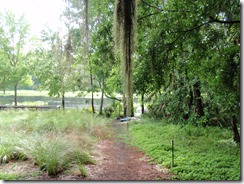 The path is surrounded by landscaping, but hasn’t been landscaped itself and there are no signs prohibiting boat launching, so I’ve assumed it’s okay to use this spot until the official launch site is built.
The path is surrounded by landscaping, but hasn’t been landscaped itself and there are no signs prohibiting boat launching, so I’ve assumed it’s okay to use this spot until the official launch site is built.The site itself, though, is pretty cramped right now and it’s a bit tricky to maneuver a large boat onto the water and back to shore for boarding.
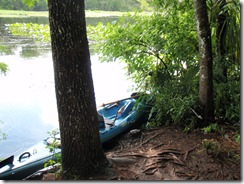 Once on the water, you can see that you’re only a short distance from the SR 46 bridge.
Once on the water, you can see that you’re only a short distance from the SR 46 bridge.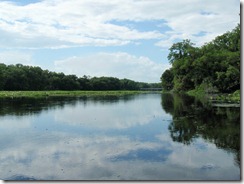 I had limited time for this trip, starting at 5:00 and needing to be off the water by 7:00 in order to pick up my daughter at 7:30, so I started upstream – planning to paddle until six and then head back to my launch point.
I had limited time for this trip, starting at 5:00 and needing to be off the water by 7:00 in order to pick up my daughter at 7:30, so I started upstream – planning to paddle until six and then head back to my launch point.GPS tracking powered by InstaMapper.com
Shortly into the trip, though, I found that staying by the right-bank had been a mistake and the channel I’d followed became clogged and impassable.
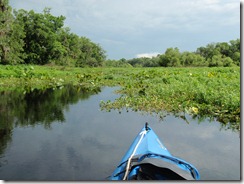 After heading back downriver, I decided to keep going that way, rather than retracing my path nearer the left-bank, so I headed for the bridge, taking a couple photos along the way.
After heading back downriver, I decided to keep going that way, rather than retracing my path nearer the left-bank, so I headed for the bridge, taking a couple photos along the way.
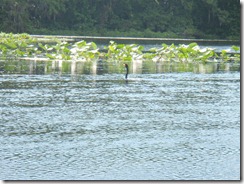
 The Wekiva’s an interesting river, because it can change from the very open river I started paddling in to a much closer, tree-lined river in a very short distance – as it does, just after the bridge, splitting into two channels with a tree-covered island between them.
The Wekiva’s an interesting river, because it can change from the very open river I started paddling in to a much closer, tree-lined river in a very short distance – as it does, just after the bridge, splitting into two channels with a tree-covered island between them. And then opening up again just as rapidly.
And then opening up again just as rapidly.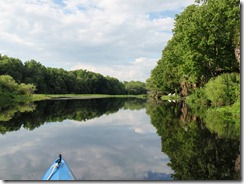 Ducks were out in force this trip and I saw quite a few of them.
Ducks were out in force this trip and I saw quite a few of them.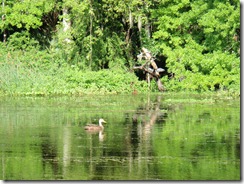 And farther down river, two deer were getting an early dinner.
And farther down river, two deer were getting an early dinner.
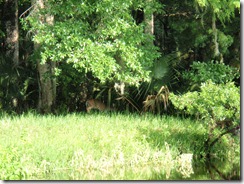 You’d think after almost forty years in Florida, I’d know what some of these damn birds are, but I really have no idea. I got a decent picture of this thing, though.
You’d think after almost forty years in Florida, I’d know what some of these damn birds are, but I really have no idea. I got a decent picture of this thing, though. And to think the mess I’d driven through earlier turned into this:
And to think the mess I’d driven through earlier turned into this: Ducks I can recognize, though, and this one seemed to not care at all about me.
Ducks I can recognize, though, and this one seemed to not care at all about me.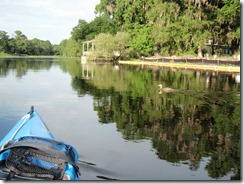
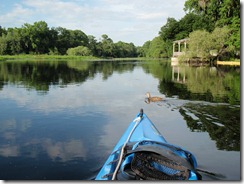
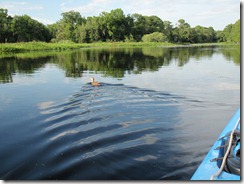 By this time it was six and time to turn around, but looking ahead I could see that I wasn’t nearly out of river yet …
By this time it was six and time to turn around, but looking ahead I could see that I wasn’t nearly out of river yet … Surely I could paddle a little farther and still make it back in time? Right? I decided to paddle until 6:15 and then head back.
And I’m glad I did, because just a little ways downstream an alligator left the reeds ahead for the far side at my approach.
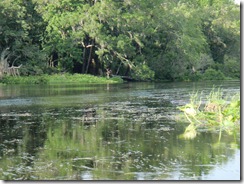
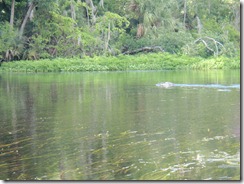 He was followed by a second, larger one, who reached the far shore and then paralleled my course for a while.
He was followed by a second, larger one, who reached the far shore and then paralleled my course for a while. Shortly thereafter, I ran across this plant – not sure what it is, but it looks nice.
Shortly thereafter, I ran across this plant – not sure what it is, but it looks nice.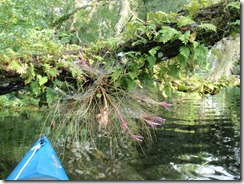 At this point, it’s 6:08, so I decide to turn around and head back … mostly because my watch is slow and it’s really 6:12.
At this point, it’s 6:08, so I decide to turn around and head back … mostly because my watch is slow and it’s really 6:12.Remember all those big open spaces on the river … well, now the current’s against me and the wind seems to have picked up and is funneled between the trees and I have to hurry back to the put in.
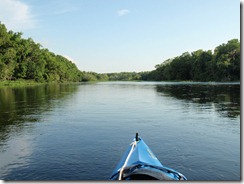 Why does this little stretch of river seem so much harder to paddle than the open-ocean side of Honeymoon was Friday?
Why does this little stretch of river seem so much harder to paddle than the open-ocean side of Honeymoon was Friday? Finally, ahead of me, the river splits and I paddle into the narrower channel on the right-bank. Once I’m through this tree-covered area, I’ll be going under the bridge and then it’s just a few hundred yards to the park.
 Not quite at the right split yet, and the homeowners have built a wall across the river – probably too many boats cruising through ignoring the No Wake signs. So I have to backtrack and get out of this dead end, but if I hadn’t taken it, we wouldn’t have this picture of a pony in someone’s back yard.
Not quite at the right split yet, and the homeowners have built a wall across the river – probably too many boats cruising through ignoring the No Wake signs. So I have to backtrack and get out of this dead end, but if I hadn’t taken it, we wouldn’t have this picture of a pony in someone’s back yard.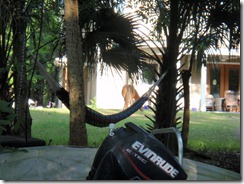 Yes, the best picture I could get was of the horse’s ass. I’m in a hurry and have to get off the water by 7:00 or I’ll be late picking up my daughter – give me a break.
Yes, the best picture I could get was of the horse’s ass. I’m in a hurry and have to get off the water by 7:00 or I’ll be late picking up my daughter – give me a break.As an aside, is that really a pony, or is it a demondonkey?

I’m just asking.
Saw another large alligator cruising ahead of me, but he submerged before I got close enough for a photo. And now that I’m hurrying, fighting against the current and the wind to get back and off the water by 7:00 so I won’t be late for that 7:30 pick up, there’re smaller gators on every freakin’ dock I pass, it seems. No time for pictures of them, though.
Finally, I’m in the right channel and reach the bridge.
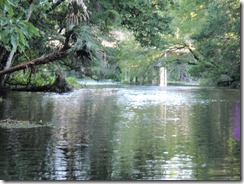 And back to Wilson’s Landing where I can get off the water.
And back to Wilson’s Landing where I can get off the water. Yes, that’s the target I have to line my 16’ boat up against, get close enough sideways to step out onto land, then maneuver the boat around to pull it out. I didn’t say it was an easy site.
Yes, that’s the target I have to line my 16’ boat up against, get close enough sideways to step out onto land, then maneuver the boat around to pull it out. I didn’t say it was an easy site.Off the water, drag all the gear back to the roundabout, load the car and ready to drive only a few minutes late.
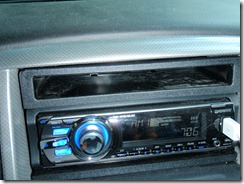 My schedule had some buffer time in it, so I’m able to make it with a couple of minutes to spare, arriving to pick my daughter up at 7:28.
My schedule had some buffer time in it, so I’m able to make it with a couple of minutes to spare, arriving to pick my daughter up at 7:28. At which time, I sit around and wait until 7:45 because her class ran long.
-
Two Mondays on the Wekiva – Part I
I was lazy last week and didn’t post about one of my trips, so will have to take care of that today.
In the past when I’ve tried to get back to paddling, one of the problems has been time. With a family there always seems to be something that needs to be done, so the “not enough time” excuse rears its head. This time, though, I’m working on the theory that two hours on the water is still two hours on the water, so I’m taking opportunities as they arise.
So since my daughter has classes several times a week, I’ve started taking the opportunity to do something other than drive home and sit on the couch before it’s time to pick her up – whether paddling or hockey or something else.
Under this premise, a friend and I headed for Wekiwa Springs State Park Monday (5/10) to get on the water.
View Wekiva River in a larger mapWith two people, the portage from the parking lot to the water wasn’t too bad and we headed out.
GPS tracking powered by InstaMapper.com
The GPS went a little hinky and didn’t track as often as it should have, but we first headed up Rock Springs Run until the water got so shallow in spots that we had to get out and pull the kayaks.
This bird was there on our way up Rock Springs Run and didn’t budge as we went by. After we paddled upriver for a while and came back, he was still there – apparently unmoved. We considered the possibility that he was some taxidermists prank until we got close enough to make him stalk off indignantly.
Once off Rock Springs Run and back on the Wekiva, we found the Wekiva Marina much changed since my last visit and pretty busy for a Monday afternoon.
Last time I was on this river, the marina was pretty dilapidated and didn’t get much traffic. It looks like things have had significant changes. I’m going to have to stop by and check it out.
Further down the river, we came across this little place, posted No Trespassing by the Florida Farm Bureau.
Not sure why it’s there or what it’s used for.
Not much wildlife on this trip, but all along the route we saw signs of the most invasive species in Florida.
I really don’t understand how people who go out on the river and clearly enjoy doing so can so casually toss crap everywhere – do they not care if they’re swimming and fishing in a garbage dump?
-
Honeymoon Island
I had a bit of a later start than I planned this morning, due mostly to a muttered “oh, hell, no” and slap at the alarm clock around 0-dark-thirty.
Once up, though, I loaded the car and hit the road for Dunedin, FL, stopping just twice:
- Subway for breakfast and lunch – their new breakfast is pretty good, easily in the top five of semi-fast-food, after Panera, Starbucks and Chick-Fil-A, and the cheapest of the four. Quite a bit above McDonald’s or Burger King. Plus you can pick up a cooler-friendly lunch at the same time.
-
The Best Buy in Dunedin to pick up an iPhone battery. Yes, I know you can’t replace the battery in them. I was looking for either a solar charger or charger that uses regular batteries, because I’ve been using the iPhone as my GPS tracker on trips (safely ensconced in the deck bag, of course), but the GPS eats battery life. What I found was this thing from Energizer that works as an external rechargeable battery:
So far, so good – it ran the iPhone for GPS tracking over four hours today and the phone still had a full charge.
A good put-in to paddle either Honeymoon Island or nearby Caladesi is from the Dunedin Causeway.
View Dunedin Causeway in a larger mapView Dunedin Causeway Put In in a larger map
You can enter the state park on Honeymoon Island, but the portage from parking lot to beach is a lot longer than on the causeway:
Of course I still haven’t repaired the seat padding that blew off, so I had to improvise an
ass-padcushion.All in all a folded towel is okay, except for the part where it gets saturated and you sit around in salt-water all day … but the Tarpon’s a wet boat anyway, so I didn’t really notice.
My goal today was to circumnavigate Honeymoon Island then paddle around St. Joseph Sound on the east side of Caladesi. With the late start and the stops, I only managed the first half of that.
GPS tracking powered by InstaMapper.com
The weather forecast called for the winds to be out of the ESE between 8 and 12 MPH, so I started my trip on the east side of the island (going counterclockwise), putting the wind and waves at my back and quarter for the first part of the trip.
I did have to paddle into the stronger wind for the latter part of the trip down the west side of the island, but it was a much shorter distance to face that than the east would have been. You can see from the GPS track that I was a lot slower on the West side, especially when I got far enough south to be out of the lee of the island.
I passed near Grassy Key on my way north, a small mangrove island.
Most of the southeast portion of Honeymoon is mangrove also, with no beaches or stopping places.
It’s not until you round the northernmost headland of mangroves that the shore begins to offer places to beach.
I stopped three times on the east side of the island.
The first stop was because I had to pee. I know, TMI, but under the Florida sun: If you don’t have to pee, you’re not drinking enough. Something Florida paddlers should keep in mind. I also picked up about a dozen cans and bottles at this stop to dispose of properly.
The second stop was because I thought I remembered there being an easy portage spot there – clearly I was mistaken, since that stop was at about the widest part of that portion of the island. So much for my memory.
And the third stop was because an osprey had perched on very low post.
The wind and waves were driving me right to the beach at the base of this short dune, so I was able to keep still and exit the boat out of his site. This let me get a lot closer for a picture.
The north end of Honeymoon is roped off and signed as restricted to protect nesting birds. The sandbar there is also a gathering spot for the feathered ones.
Rounding the north end of the island presents you with a view of the open Gulf.
The ocean-side of Honeymoon should be considered an open-water paddle. Unlike the sheltered sound to the east, the west-side can get the full force of wind, waves and currents. A basic understanding of currents and tides is helpful and you should be comfortable having nothing on one side of you until Mexico.
The combination today was a light wind out of the south and a moderate swell out of the south. Since I had to go south, this made the second half of today’s paddle more challenging. But I find swells easier to handle than the chop the wind was kicking up on the east side, so I’m glad I went counterclockwise today.
The northern beaches on Honeymoon are the farthest from the parking lots, so they’re not very crowded.
But this changes as you head south.
I saw only one dolphin on this trip, that just as I was turning east around the south end of the island. I wasn’t able to get a picture, because he only surfaced twice, both times quickly and heading north.
I pulled onto the beach at the very southern tip of the island, just before the channel and crossing to Caladesi, where I had a quick lunch. As soon as I had my sandwich in hand, this guy showed up to try mooching a bite.
His presence also irritated a couple other gulls who were busy with the preliminaries to seagull sex.
After lunch, I crossed the channel to the Caladesi side.
But I decided to call it a day and head for the causeway and home.
-
Getting Back in the Paddle
So, yes, it’s almost two years since I made a paddling post and, sadly, almost one year since I took the kayak out at all. A short trip last June with the kids was it. And it really shocked me when I realized how long it’s been.
So today’s trip was more of a preliminary jaunt to see just how out of shape I am and how much work it’ll be to get back in paddling form. With that in mind, I headed for Moss Park – it’s a pleasant, easy, lake paddle for me to get back into the swing of things.
Some things have changed at Moss Park since the last time I was there. First, the entry fee has changed – it used to be $1 per person, now it’s $3 per car. Second, they’ve paved some more of the roads and rebuilt the western boat ramps.
I don’t mind paying a couple dollars more to support the park, but I’m sad about the paving. I liked the sound and feel of gravel under my tires and feet and the old wooden dock. Now they have paved parking, two powerboat ramps and a new dock. There’s also a paved loading/unloading ramp near the kayak/canoe launch.
Unfortunately, they also paved a ramp, accessible only by sidewalk, for canoe/kayak launch. I hate concrete ramps for kayak launching. Who wants to drag their boat up a concrete ramp? Luckily there’s still some grass next to the concrete.
Unfortunately, as soon as I walked back from the parking lot, I found that this guy was pulling out and left his boat there while he went to get his car.
Which left very little space for me to launch.
A very positive change at Moss Park, is that they’ve started handing out a new flyer to boaters with some basic rules and a map of the two lakes (Hart and Mary Jane).
This map includes depth lines. I think this is a great thing for them to do, because the Lake Mary Jane side is where most of the boaters and jet skiers go, but there’s a sandbar in the middle of the lake – depending on rainfall, it can be between 2’ and 2” deep, so notifying those new to the lakes is a pretty good idea.
So I got onto the water and started down the half-mile channel from the ramp to Lake Hart.
When I got to the end of the channel, I found that the wind was fully out of the West (I checked later and found it was a 13 mile an hour wind today), with a 1.5 mile fetch across the lake, there was a lively set of waves worked up.
My original plan had been to paddle the perimeter of the lake, but wind and waves changed that. I love paddling in weather and surf, so I headed due West across the lake, right into the teeth of the wind. I figured that would give me a really good idea of just how far I needed to go to get back into shape.
What surprised me was that I noticed after a time that I was halfway across the lake and hadn’t stopped paddling. Now I’m usually a rather leisurely paddler – I stop frequently, have a drink, look around, rest. To have gone over a mile (from the put-in to mid-lake) without stopping a couple times is unusual on even a calm day. So I pushed on, determined now to make it all the way across without stopping.
It seems I’m in better shape than I expected – even though I’ve been largely sedentary for the last couple years. Within the last month or two, I started doing a lot of work around the house – moving furniture for tile, putting up a fence, painting, etc – and also started ice skating more as the boy-child and I learn to play hockey. So things aren’t as bad as I feared.
I made it to the far-side of the lake without stopping, except to take this picture, until my bow touched the reeds on the far shore.
It wasn’t entirely easy, my arms and shoulders were burning a little, but that has more to do with my paddling form sucking than anything else – I tend to use my arms more to paddle, instead of my torso.
From there, I decided to head South around the perimeter of the lake and take a moment to investigate a big, blue thing someone had on their lawn. Turned out to be a huge waterslide.
Whatever happened to the simple Slip-n-Slide? This thing wouldn’t even fit in a normal sized yard.
A bit further South, away from the screaming children and the constant roar of blowers and the generator needed to keep this monstrosity inflated, I came across someone who’d set up an alligator feeding-station.
At least that’s the reason I can come up with for the free-running goats.
At the South end of Lake Hart is an irrigation dam and my favorite sign.
I’m still not sure why this sign says “DANGER” and not “Admission – $10”.
Past the dam I leave the lee of the far shore and pick up the wind again, paddling with a following sea, then turn north to get back to the channel, which lets me wallow along in a cross-sea. Whee.
I decide to call it a day, not because I’m tired, but because my butt hurts. The seat cushion on my yak blew off a while back and I haven’t replaced it yet. But once I have that replaced, it seems I’m not as out of shape as I thought I was and I can start going on more interesting routes.
(view this route in Google Earth)
GPS tracking powered by InstaMapper.com
-
GiSTEQ PhotoTrackr Lite – A New Toy
Having been on vacation this last week not only gave me the chance to do some paddling, it also gave me the chance to try out a new toy.
When I started this blog, one of the things I wanted to do was to provide photos of the trips to Google Earth via Panoramio. One of the things I quickly found out was that mapping photos of a river trip by hand is a pain in a different body part.
Let’s face it, if you’ve just taken a picture here:
It’s pretty easy to tell Google Earth where you were when you snapped the photo.
On the other hand, the question "where was I standing when" becomes more problematic when it was somewhere in here:
I want to paddle, not keep track of river bends, so I went looking for something to do this automatically and found this little toy:
This is a simple GPS receiver that just records your location every 15-seconds when it’s turned on. Where this becomes useful for photography is when using the included PhotoTrackr software.
PhotoTrackr allows you to select a group of a pictures and a trip record from the GiSTEQ device. It then uses the time the picture was taken to match it up with a location in the trip record and encodes the location in the pictures’ EXIF information. Now, when you upload the picture to a service like Panoramio, Flickr or Picassa, those services can read the geotag information included with the picture and map it automatically.
In addition to mapping pictures, the PhotoTrackr software will also map your entire trip on Google Maps or export a KLM file for use with Google Earth — features I use to create the maps, route pictures and Google Earth downloads for this site.
Overall I’m pleased with the GiSTEQ device. The battery life could be better (1-AA runs it for about 10- to 12-hours) and there are short gaps in the recording. A single trip might be broken into several segments in the software and I’ve seen some gaps of up to a few hundred yards in the recording. I’m hoping a firmware update will resolve this once I have time to do the update.
I also had a problem with the install. It calls for getting a Google Map API Key (this would be the key the software uses to identify itself to Google Maps for displaying maps within the software). The install process sends you to the Google website to retrieve this key, but the site asks for a web address — the PhotoTrackr install doesn’t make it clear that it’s the GiSTEQ website you have to enter here (http://www.gisteq.com/). Once I found that tidbit on the GiSTEQ support forum, everything was fine.
-
Wekiva River
After nearly soiling myself passing a very large gator at close range on the Econlockhatchee, I decided something more leisurely and sedate was in order, so I headed for Wekiwa Springs State Park to paddle the Wekiva River.
The springs and the river actually do have different names, it isn’t an alternate spelling. Wekiwa refers to the springs — water coming out of the ground; while Wekiva means water flowing over the ground.
If you want a peaceful, tranquil Florida river experience, the Wekiva is a good choice … unless it’s a Saturday during Summer. Wekiwa Springs State Park frequently closes due to capacity being reached on Summer weekends and the river teems with boaters … most of them in rented canoes with no idea what they’re doing and less interest in the serenity of nature.
Near the headwaters of the Wekiva you have a choice of putting in at either the State Park or Wekiva Marina (about a mile downstream from the springs).
I chose the State Park because the fee to put in is a couple dollars less. If you put in at the Marina and then want to paddle to the Park, there’s a small fee to enter the Park as well.
One issue with launching your own boat from the State Park is that the water is some distance from the parking. There’s also a hill involved and the trail is rather soft sand in some places. It’s not that bad getting to the water, since it’s downhill from the parking lot … the bad part comes later.
The put-in is on the Wekiwa Springs pond, just below the swimming area.
Since my little misadventure on the Econ had eaten up some of my time this morning (and thankfully that was all that was eaten), it was after 9:00 AM when I got to the springs and people were already on the water. It was still early enough, though to get a bit of mist and early morning sunshine through the trees.
About 3/4 of a mile from the springs, Rock Springs Run joins the Wekiva. This is a smaller, less-traveled tributary that I enjoy paddling and I started up it a bit before returning to the Wekiva.
A full mile from the State Park is Wekiva Marina, where you can also put in or rent a canoe.
Shortly past the marina, I came across a small alligator — a much more pleasant encounter than the one earlier in the day. In fact, on most trips down the Wekiva I’ve encountered a small gator in this area, just downstream of the marina.
It’s at this point in writing this blog entry that I come to the realization that the little Argus Bean camera I got for these trips just isn’t going to do it for me. Most of the pictures I took on this trip didn’t come out well, so I’m going to have to try something better.
After pointing out the little gator to the next group of paddlers coming down the river, I leave him behind and encounter a new form of wildlife — kayaker without PFD:
If you look closely, you can see her head behind the nice Fish and Game officer’s boat … her head’s right next to the officer’s ticket book, which she got a very good look at.
Is it really such a hardship to have a PFD in the boat?
Past the legal action, I saw bubbles start to break the surface of the water near the shore, then a stream of bubbles race across the width of the river. A line of bubbles breaking the surface usually means an otter and a bit of patience tracked him down when he surfaced near a fallen tree to munch on a fish.
I love watching otters and had the good fortune to once rent an apartment that had been built around a natural pond that acquired a family of them. For several months I was able to watch them from the comfort of my balcony:
After passing the otters, I saw some turtles on a log:
This is the obligatory, Florida, Turtle on a Log picture. I do not plan to take or post any more pictures of Turtle on a Log, no matter what river I see them on.
Now, don’t get me wrong, I like seeing Turtles on a Log — no matter how many times I see them, it’s a nice reminder that I’m on the water, away from the city. But, let’s face it, there’re a lot of Turtles on a Log. And anyone who paddles, especially in Florida, has seen more than their share already, so pictures of them aren’t really necessary.
So, from time to time, if I feel it’s useful for the ambiance of the trip report, I’ll just throw in:
You’ll know what I mean and it’ll save everyone’s time and Internet bandwidth. If you truly feel compelled to see another picture of Turtle on a Log, you can click the link and come right back here to one.
Of course, I’ll still take and post a picture if I feel it’s noteworthy, for instance if I see Unusually Large Turtle on a Log or Very Large Number of Turtles on a Log. Definitely if I see the very rare: Log With No Turtle.
I started paddling again …
(see how nicely that works?)
About 1/2 a mile downstream of the marina, the river appears to split around an island you can recognize by the lone palm tree next to a bare bank:
The left channel is the main, navigable river, but the island is a frequent stop to rest and relax. Farther along its shore are several rope swings and later in the day this spot will be packed with people picnicking and playing in the water.
The rest of my paddle down river is mostly uneventful …
<Turtle on a Log>
<Turtle on a Log>
<Turtle on a Log>… though I do get my best quality pictures of the day out of the Argus Bean when I come to an open area of the river and want to capture the beautiful sky I’m paddling under:
After a couple hours of paddling …
<Turtle on a Log> ^ 10
I do encounter some very tolerant birds that let me get quite close for a picture. These are without any zoom:
Once back between the marina and the park, I once again encounter the large crowds on the river this summer weekend. The attendant at the springs put-in told me they had eighty boats on the water — possibly an exaggeration.
One day, I’m going to come here and just paddle the mile between the park and marina, back and forth, all day, watching the people in the rented canoes. Some know what they’re doing, but for others it’s a crap-shoot whether they’ll make it off the river alive.
Best quote of the day (from a wife in the front of a canoe with a paddle across her lap):
"You’re heading right for another tree!"
The tree in question was at least fifty feet away and the look on the husband’s face was priceless.
My favorite was this lady. She has three kids with her in two canoes. She has tied the canoes together and is the only one paddling — the kids mostly just sit there with their paddles. Here she is crossing the river in front of me:
Now, here she is crossing the river back the other way:
And back:
Here the Bean failed me again, but she’s recrossing the river right in front of another canoe (keep in mind her two are tied together and the oncoming canoe has the current behind it). I’m cringing at this point, waiting for the clothesline flag to be thrown and ready to assist the soon-to-be victims.
Luckily, the oncoming paddler was able to slow down enough to avoid disaster.
Once back at the State Park put-in, the truly horrid part of the trip is facing me: getting the boat back to the car.
After trudging up the hill to retrieve the kayak cart from the car and back down to the put-in, I make sure everything’s secure on the boat and start the trek … uphill … through the soft, soft sand.
At the top of the initial hill, there’s a choice to be made. I can turn right past the concession stand and then up the narrower, steeper trail to where I parked, or I can go left through a picnic area — that way is longer, but not as steep.
I’m 41-years old, out of shape and need the exercise, I take the hill. Besides, they’re grilling in the picnic area, I can smell it. I’m hungry after the morning’s paddling and the turkey sandwiches waiting in my cooler just aren’t what I want. If I have to drag this damn boat past burgers and barbeque, there’s going to be an Incident.
So up the hill. But not all at once. The goal is to get the heart pumping, not exploding.
First, the short pull across level ground to the restrooms, which is an excellent excuse to stop for a moment. Then start up the hill to the gate and pause again, looking longingly back at the hot dog cart outside the park’s concession. If they were grilled, I’d be all over it, but they’re boiled and even the turkey in the cooler’s more appetizing than that.
Now up the hill to the halfway point, where I wheeze for a little while, muttering about how if I’d taken the other path I’d be eating a burger right now while fending off its owner with a BBQ fork.
And one final pull to the parking lot where I load up the car and settle in to the air conditioning to eat my turkey sandwich. Yum.
